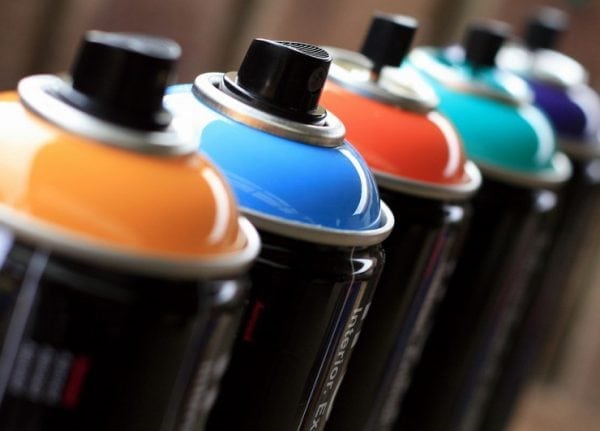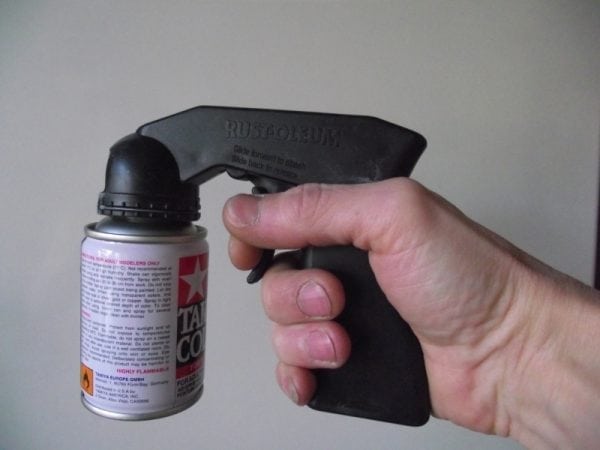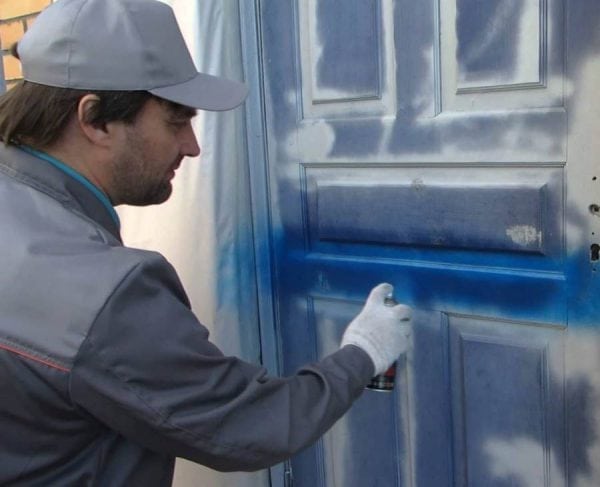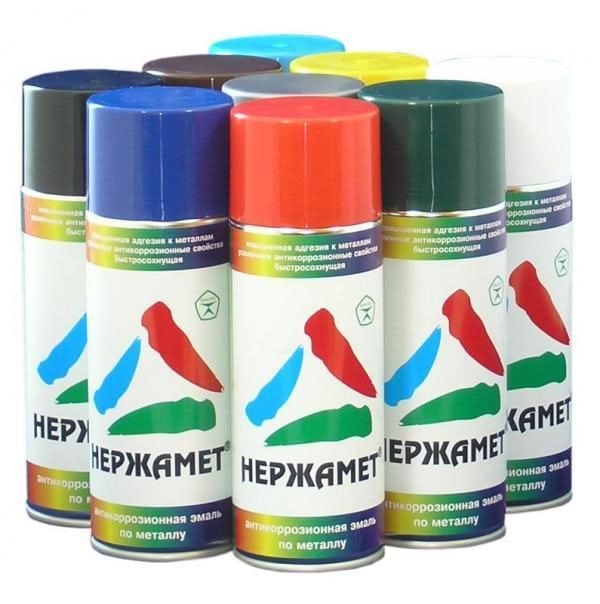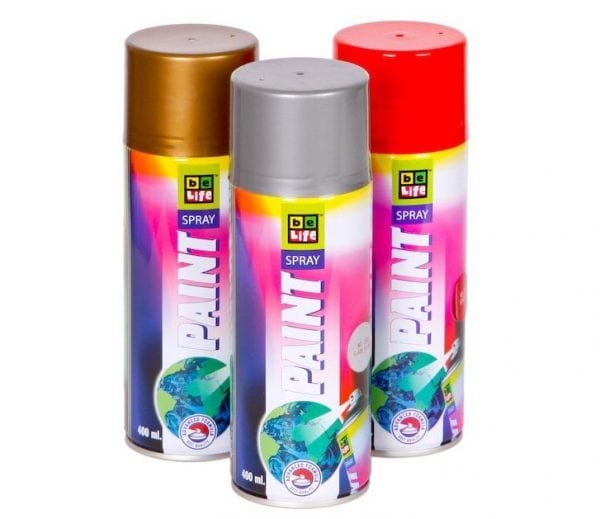Spray paint is indispensable for painting small parts and hard-to-reach surfaces. Aerosols are also widely used in restoration and decorative works (screen drawings, graffiti).
- Advantages and disadvantages of aerosols
- Aerosol Selection Tips
- Nozzles
- Painting technology
- Aerosol varieties
- Spray paints for metal
- Heat Resistant Compounds
- Compositions for plastic
- Decorative compositions
- Useful Tips

Advantages and disadvantages of aerosols
Structurally, the spray can is very simple. The tank is filled with gas and paint, which are under pressure there. The function of the gas is to maintain equilibrium among the components of the content.
Advantages of aerosol paints:
- The paint is always ready for use. Before painting, you just need to shake the spray can.
- Aerosol formulations are the best choice when it comes to painting small-sized parts or hard-to-reach areas, since the sprayed particles fall even into barely visible recesses.
- During operation, you can completely do without additional tools (brushes, rollers).
- Aerosol paint has the same performance characteristics as cans: the level of adhesion, elasticity, resistance to abrasion, moisture and ultraviolet.
- Aerosol mixtures dry very quickly (5-6 hours).
- Spray cans are convenient to store and transport. Paint in such containers practically does not dry out during storage. In addition, the cans are more airtight than other types of packaging, which eliminates specific paint and varnish odors.
- There is a wide selection of colors.
- There are paints with special effects, including hammer, pearlescent, fluorescent, metallic, textured. Using this composition, you can give the surface a glossy, semi-gloss or matte look.
- Thanks to spraying, color reproduction from one color to another is particularly smooth.
Disadvantages of aerosols:
- Mixing multi-colored paints is unacceptable.
- It is advisable to have experience working with aerosols, because due to a lack of skills, beginners often allow drips.
- To get a clear border, you will need a stencil or masking tape.
- You can not make the paint less thick with a solvent.
- Work can be carried out only in the absence of wind, because otherwise the inevitable hit of paint not only on the painted, but also on all nearby surfaces.
Aerosol Selection Tips
There are several recommendations that will be followed by choosing the right paint material:
- When choosing, you need to consider the material to be painted. Acrylic based compounds are used for plastic, glass and wooden products. For metal, you need a zinc paint spray with the addition of aluminum. Ceramic and enameled surfaces are painted with epoxy-based enamels.
- Choosing the right tone will be easier if you use the catalogs of paint products (RAL, NCS).
- You can choose compositions with special decorative properties, for example, with the effect of embossing, fluorescent glow or under the "metallic".
- The total amount of purchased composition must be calculated based on the consumption rate indicated on the bank. In this case, it is necessary to provide for the application of material in 2-3 layers.
to contents ↑Note! Some manufacturers produce refillable cylinders. They are not too common, but still apply to some jobs. Such a can should be periodically filled with both gas and paintwork material.
Nozzles
Application of paint and varnish material to the surface is carried out using a special device - nozzles. You can buy a nozzle separately from the spray.
Spray nozzles with paint are inexpensive, so they can be purchased in several types:
- Thin nozzle allows you to paint the surface with a thin stream. Designed for fine detail. Using a thin nozzle, lines are applied with a thickness ranging from 0.8 to 4 centimeters.
- Medium nozzles are used for applying strips up to 5 centimeters wide.
- Thanks to the wide nozzles, you can output 10 centimeters across the width of the strip.
Advice! The nozzle must be selected so that the pressure level in the can does not exceed the permissible pressure for this part. The fact is that different manufacturers of paint in cylinders set different pressure levels. This indicator is not critical, however, it has some influence on the final result of the work.
to contents ↑Painting technology
To obtain a qualitative result when applying paint with a spray can, you must adhere to certain rules:
- To avoid poisoning the contents, it is necessary to use protection, namely a respirator, goggles or a mask.
- Before applying the paint, the surface should be prepared: remove dust, dirt, and also degrease with white spirit. It is also necessary to apply soil to the surface (preferably a special aerosol, although normal can be used). To ensure the highest quality, it is recommended to use a primer and spray paint from one manufacturer.
- Surrounding surfaces must be protected against accidental paint. For this, masking tape is suitable. In addition, it is advisable to have a rag at hand, which, if necessary, can remove unwanted traces of fresh paint.
- In order for the paintwork material to acquire a uniform consistency, the container must be shaken well several times. At first, it is recommended to make a test stain on the test surface - this will assess the uniformity of the composition.
- When staining, keep the spray can with the nozzle in the direction of the surface to be painted at a distance of about 25 centimeters. The paint is sprayed so that the pigment lies on the surface in 2-3 layers. However, excessive layer thicknesses should not be allowed, as excess paint can cause sagging.
- Spray painting should be carried out only in calm, not cloudy weather.
- The surface to be painted should ideally be horizontal. If we are talking about a vertical surface (for example, a wall), then painting is carried out from top to bottom, so in this case the risk of sagging is reduced.
- After applying the first coat, wait for the initial drying of the paint. The approximate waiting period is 30 minutes. When the coating "sets", you can begin to apply the next layer.
- Full drying of the paint occurs after 5-6 hours. However, in some cases, drying should be expected for several days.
- If necessary, fix the painted surface, you can use acrylic varnish.
to contents ↑Note! Aerosol formulations are flammable, so keep them away from open flames. This rule applies to both storage and spraying.
Aerosol varieties
Spray paints for metal
- Water-based eco-enamels for facade and interior surfaces. They have a characteristic vanilla odor. Such formulations dry out quickly. If the paint is applied to any surface by mistake, it must be washed off within 30 minutes, otherwise then it will be much more difficult. Eco enamels reliably protect the coating from the effects of ultraviolet radiation.
- Paints for coloring metal are produced in three varieties: standard, double and triple.The standard one is used only to give the surface a given shade. Double contains a primer. Triple spray paints in spray cans include a rust converter.
Heat Resistant Compounds
Thermally stable paints (containing oxygen and flint) are used primarily to protect the material from high temperatures. In addition, heat-resistant surfaces tolerate moisture and exposure to aggressive chemicals.
Fields of application heat resistant aerosols:
- In the form of a protective coating for metal, wood, ceramic, concrete substrates.
- For coloring products subject to increased thermal stress (stoves, boilers, fireplaces, etc.).
- Light accumulating characteristics of the paint are used for road marking.
- For the treatment of surfaces that function not only at high temperatures, but also with high humidity (saunas, pools, etc.).
to contents ↑Note! Thermal resistant paints and varnishes can be applied at temperatures from 15 degrees of frost to 40 degrees of heat. Humidity has a direct effect on the drying rate of the coating.
Compositions for plastic
Spray paint in cans for plastic most often used in the automotive industry. It forms a coating that is protected from moisture, resistant to abrasion and aggressive chemicals. As a result of staining, the surface becomes velvety, rough or glossy.
There are several types of aerosols for plastic:
- Polymer (acrylic). They are characterized by high adhesion. They include a primer. Acrylic paint in cans is similar in technical characteristics to enamel.
- Abrasion resistant mixtures are made on the basis of polyurethane resins. After staining, the surface becomes glossy.
- Structural paints and varnishes are used to smooth out small irregularities and are characterized by a high level of thixotropy. Processed plastic gains smoothness.
- Tactile paints based on acrylates and polyurethane resins give the material a velvety feel.
- Polyvinyl chloride mixtures have significant adhesive properties and protect the coating from the negative effects of ultraviolet radiation.
Decorative compositions
To decorate surfaces, a special type of paint is used - RAL palette. There are many shades, each of which has a corresponding number. You can select the desired paintwork material according to the palette table.
Decorative spray paints used for painting double-glazed windows, cans, flasks, as well as for creating complex patterns using a stencil.
Do-it-yourself stained glass is dyed using the following technology:
- Glass is cleaned with household cleaning products and wiped with a dry cloth.
- Masking tape creates a plot for staining.
- The surface is degreased. During further work, you need to try not to leave fingerprints on the glass.
- Paint and varnish material is applied in a thin layer on the glass. The spray can is approximately 25 centimeters from the surface.
- After 20 minutes, another layer is applied.
- After 40 minutes, you can remove the tape.
If necessary, apply two colors, tape over the dried areas. After that, you can apply the drawing.
to contents ↑Useful Tips
- To remove traces of corrosion from metal, it is recommended to use household chemicals or baking soda. Substances are applied to the surface with a brush. After 40-45 minutes, the material is cleaned with warm water.
- You can turn a smooth texture into a rough texture if you use sandpaper. Due to the roughness, adhesion is significantly improved.
- It is recommended to polish wood before applying paint with a grinder.
- After applying the paint, the product should be left in a non-residential premises to allow all odors to disappear.
Due to their practicality, relative ease of use and affordable prices, paint and varnish compositions in aerosol cans have become very popular among home masters. Such paints are indispensable when performing minor repair and decoration work.


